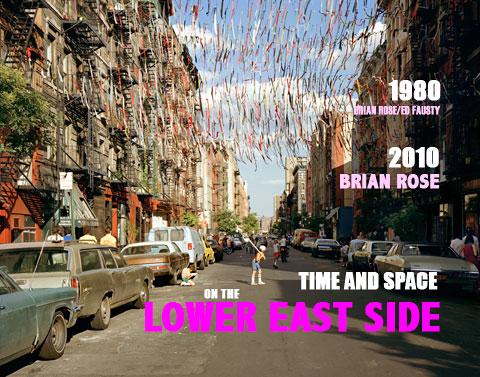Since uploading my book to Blurb last week, I’ve gotten some welcome publicity for Time and Space on the Lower East Side. Here are some blogs that have taken note:
EV Grieve, 1st post
EV Grieve, 2nd post
City Room, the New York Times
Time and Space on the Lower East Side is a project begun in 1980 when Ed Fausty and I–both recent Cooper Union grads–photographed the neighborhood with a 4×5 view camera. After the work was exhibited at the Henry Street Settlement in New York and in Nancy, France, the photographs have remained in my archive unseen until now.
In the aftermath of 9/11 I began thinking of a way to address what had happened to the city. I finally concluded that the best way for me to respond was to return to where I had started, the Lower East Side. Major changes were sweeping the city post 9/11, the great irony being that the result of such a destructive act was a flood of money and people into New York, especially Manhattan. The Lower East Side in the past century had mostly escaped the flow of wealth from one part of Manhattan to another. It remained a mostly poor, immigrant, neighborhood tucked beneath the bridges and the skyscrapers of Wall Street. It would not escape this time. Larger historical and economic forces intervened, and the invisible boundary between the Lower East Side and the rest of the city was breached.
I restarted my project first by attempting to print the 1980 photographs, and I quickly discovered that the color film had deteriorated making it nearly impossible to make a satisfactory print. I then experimented with scanning the 4×5 negatives–pushing and pulling the color this way and that–and eventually found that it was possible to recover the original color, and in some cases get more out of the negatives than in the earlier analog prints.
In 2005 I began re-photographing the neighborhood, retracing my steps with the view camera, this time working alone. I decided from the beginning that I did not want to do a simple before/after look at things. Although it’s always interesting to compare such images, it is an extremely limited concept of seeing and evaluating the passage of time. I wanted to rediscover the place with fresh eyes, with the perspective of time, change, and history. The result, still being added to, is a set of photographs that looks backward and forward, that posits the idea that places are not simply “then and now,” but exist in a continuum of decay and rebirth.
By 2010 I had made hundreds of new photographs of the Lower East Side. My first attempt at a book proposal went nowhere. The publisher of my earlier book The Lost Border was not able to take it on, and another well-known New York photo book publisher expressed disappointment that it was not a before/after book. Should have known. So, I decided to create my own book, float it out there, and see what kind of interest there was. The hope is, that a publisher will take an interest, and that a museum or gallery will do an exhibition.
In the meantime, the book is available to page through on Blurb’s website. I’ve priced the book very low, considering that it is a limited edition, one book at a time printing. Please buy if you can, or leave a comment on the Blurb site. Your support and encouragement is appreciated.
The book can be seen here or by clicking on the image above.

Your book looks incredible! I need to get this.
Thanks Oliver.
Brian
Congratulations! Photographing NYC is not as easy as some may think when you’re trying to create something fairly fresh and memorable. First, so much of it has already been done in almost every way imaginable, and the lack of a horizon line alone can often turn your best efforts into a flat, two dimensional nightmare (Lee Friedlander said something to the effect that one must throw out all compositional rules when photographing NYC).
I walked many of these streets many a time and could never successfully capture their strength and character within the confines of a photograph- so I applaud both your dedication, and achievement (can’t tell ya how many times I tried to get a good shot of that water fountain, if that’s what it once was, at Thompkins Square).
PS- And it was great to gaze upon the Jefferson Bar once again.
Brian,
Love the book. I imagined several of the prints matted and framed on my wall.
Your commitment to the subject is both admirable and enviable.
I have a birthday coming up, and this is at the top of my list.